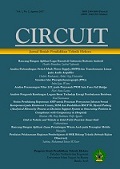Potensi Nanopartikel Magnetit Pasir Besi Lampanah Aceh Besar Melalui Studi Kajian Teknik Pengolahan, Sintesis Dan Karakteristik Struktur
DOI:
https://doi.org/10.22373/crc.v2i1.3246Keywords:
Iron Sand, magnetite nanoparticles, Fe3O4Abstract
Research on the sand iron potential in generating magnetite nanoparticles in Lampanah Aceh Besar through a study of techniques processing, synthesis methods and structural characteristics has been completed. The method used in this research is qualitative method in the kind of literature study from the data of Banda Aceh ESDM Ministry. The results of this study indicate that iron sand in Lampanah area has a dominant element which contained Fe3O4. The magnetic separation method is used to separate the iron sand from impurities, while the co-precipitation synthesis of one of the methods chosen in generating the magnetite nanoparticles which due to a simple, economical experimental process and low treatment temperature. Through the XRD test, the cubic iron sand magnetite nanoparticles with a 2ï± angle are 35,55o, 57,13o and 62,70o with the hkl [311], [511] and [440], while the TEM and SEM tests showed that the dominant particle shape is round and the distribution is tight. Therefore, controlling the size and shape of iron sand magnetite nanoparticles will provide great potential in the magnetic field of magnetism. The conclusions of this study show that the iron sand located in Aceh Besar has the potential to be a magnetite nanoparticle.Downloads
Published
2018-07-17
Issue
Section
Articles
License
Authors who publish in CIRCUIT: Jurnal Ilmiah Pendidikan Teknik Elektro agree to the following terms:
- Authors retain copyright and grant the journal right of first publication with the work licensed under a Creative Commons Attribution-ShareAlike 4.0 International License (CC BY-SA 4.0) that allows others to share and adapt the work with an acknowledgement of the authorship and initial publication in this journal
- Authors are able to enter into separate, additional contractual arrangements for the non-exclusive distribution of the journal's published version of the work (e.g., post it to an institutional repository or publish it in a book), with an acknowledgment of its initial publication in this journal.
- Authors are permitted and encouraged to post their work online (e.g., in institutional repositories or on their website) prior to and during the submission process, as it can lead to productive exchanges, as well as earlier and greater citation of published work. (See The Effect of Open Acces)

